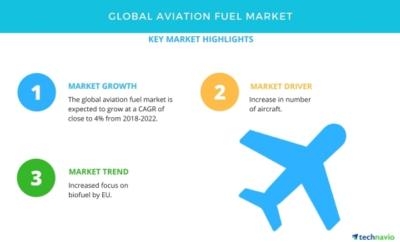Mon, Mar 19, 2018
Expected To Increase Nearly Four Percent Annually Through 2022
The global aviation fuel market is expected to grow at a CAGR of close to 4% during the period 2018-2022, according to a new market research study by Technavio.

The report presents a comprehensive research of the global aviation fuel market by product type, including ATF and aviation biofuel. The report also determines the geographic breakdown of the market in terms of detailed analysis and impact, which includes key geographies such as APAC, the Americas, and EMEA.
Recently, there has been an increase in the number of aircraft across the world. The number of people using aircraft has also increased. It is estimated that between 2005 and 2016 the number of air travelers increased by three-fourths. The growing number of passengers who commute frequently is anticipated to increase the demand for aircraft. The demand for aircraft is increasing, particularly in emerging countries such as India and China.
"The demand for aircraft will increase substantially in APAC because of the increasing air traffic in developing countries. The number of people in the middle-income group will also increase significantly over the forecast period. Also, there will also be an increase in the purchasing power of the middle-income group," said a senior analyst at Technavio for oil and gas research. "Therefore, the surge in the number of aircraft will drive the growth of the global aviation fuel market during the forecast period.”
The EU started focusing on biofuels for the aviation industry to reduce the carbon footprint of the aircraft. Some targets and policy instruments related to biofuel have already been implemented by the EU. Europe has introduced mandates for biofuels. There have also been several amendments in laws. The new amendments indicated that the share of biofuels from crops grown on agricultural land be limited to a share of 7% of the renewable energy target. This step was taken to address the problem of indirect land use for biofuels. The remaining 3% of the 10% renewable in the transport segment can be generated from other alternatives such as renewable electricity in railways and electric vehicles.
The aviation sector is linked to the price of crude oil, and its success or failure depends on the pricing of crude oil. Since July 2014, the price of crude oil was low for a prolonged period. The prices have declined continuously because of a supply-demand imbalance. The revenues of upstream oil and gas companies have decreased, which has directly affected their cash flow.
(Infographic provided with Technavio news release)
More News
Also: ANOTHER Illegal Drone, KidVenture Educational Activities, Record Launches, TSA v Shoes The Senate confirmed Bryan Bedford to become the next Administrator of the FAA, in a ne>[...]
Also: Sully v Bedford, Embraer Scholarships, NORAD Intercepts 11, GAMA Thankful Middle Georgia State University will be joining the Federal Aviation Administration’s fight ag>[...]
Also: DarkAero Update, Electric Aircraft Symposium, Updated Instructor Guide, OSH Homebuilts Celebrate The long-awaited Sonex High Wing prototype has flown... the Sonex gang tells >[...]
Also: Sully v Bedford, Embraer Scholarships, NORAD Intercepts 11, GAMA Thankful Middle Georgia State University will be joining the Federal Aviation Administration’s fight ag>[...]
30-Year USCG Veteran Aviator Focusing On Member Benefits The Vertical Aviation International Board of Directors announced its new leadership officers in April, and all began their >[...]
 Airborne 07.11.25: New FAA Boss, New NASA Boss (Kinda), WB57s Over TX
Airborne 07.11.25: New FAA Boss, New NASA Boss (Kinda), WB57s Over TX Airborne-Flight Training 07.10.25: ATC School, Air Race Classic, Samson School
Airborne-Flight Training 07.10.25: ATC School, Air Race Classic, Samson School Airborne Affordable Flyers 07.03.25: Sonex HW, BlackShape Gabriel, PRA Fly-In 25
Airborne Affordable Flyers 07.03.25: Sonex HW, BlackShape Gabriel, PRA Fly-In 25 Airborne-Flight Training 07.10.25: ATC School, Air Race Classic, Samson School
Airborne-Flight Training 07.10.25: ATC School, Air Race Classic, Samson School Rick Kenin New Board Chair of VAI
Rick Kenin New Board Chair of VAI



